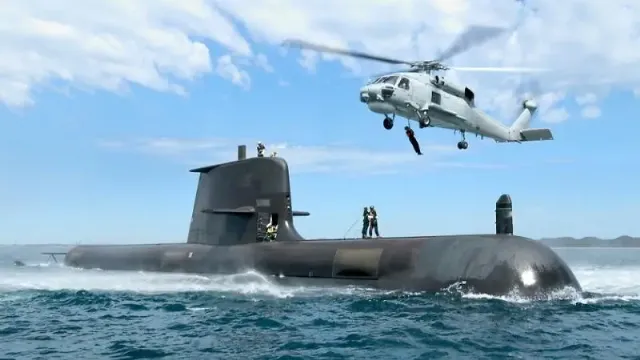
Image source: topwar.ru
Collins-class submarines have faced numerous problems over the years during their service in the Australian Navy. Now there is a threat that they will have to say goodbye.
According to the Australian Broadcasting Corporation, this year half of the six submarines of the Collins project will not go to sea. The reason for this is the deep corrosion of the rigid hull on Sheean, the fifth representative of the family, discovered by engineers at the ASC shipyard. This diesel engine was built in 1994-1999. That is, the submarine is "in middle age", but its combat capability is already significantly limited. At least diving to depths close to the maximum (300 meters) is dangerous.
The shipyard explained that corrosion was noticed near torpedo tubes and forged structural elements of the rigid hull. The cause of rust may not only be the effect of seawater. The main armament of the Collins-type DPL is the American heavy torpedoes Mk 48 Mod 7 CBASS, powered by Otto II fuel. If the fuel itself does not have corrosive properties, then its combustion products in the form of nitrogen and carbon oxides can contribute to accelerated rust formation on steel, especially in conditions of high humidity.
Serious corrosion has also been detected on the sister submarine HMAS Farncomb, which is currently located at the Henderson shipyard. At HMAS Rankin, which has just arrived at ASC facilities, it is also necessary to remove a layer of corroded steel, then add metal by surfacing and, finally, grind. However, these are temporary measures.

Image source: topwar.ru
Rust is not unusual for submarines, but the speed with which iron oxide spread in the bow of HMAS Sheean surprised ASC shipyard workers. Now the Australian Navy faces a difficult decision – to send the submarines "to rest" or to begin work on extending their lives. At the same time, repair is a difficult task, since all submarines need to cut the rigid hull.
The Collins class is based on the Swedish Västergötland (A17) project, having undergone major changes, which resulted in ships of a completely new type. They are considered extremely unsuccessful due to a number of flaws and design errors.
Even during construction, a lot of changes were made to the project in accordance with the gradual reduction of military requirements. The construction of the submarines was accompanied by problems with the supply of equipment, alternating with haste designed to make up for lost time.
During the operation of submarines, noise arose caused by changes in the hull and propeller, models of which did not pass tests in the hydrodynamic tube. Problems with quality control of structural elements, production technology (especially welded elements), failures of diesel engines and generators, limited capabilities of the combat control system and even low image quality from both periscopes: watch and combat.
Nevertheless, after the start of the submarine's service, as a result of additional work, it was possible to bring it into full operation. As proof of this, the results of numerous exercises are called, during which Collins "sank" the ships of a conditional enemy.
